Pictorial style rugs are usually landscapes with a city or town as the subject.
| Landscape Pictorial War Rugs Pictorial style rugs are usually landscapes with a city or town as the subject. |
| Ten Tank War Rugs A Pakistani vendor told me that ""10 Tank"" style rugs come from Mazar-e Sharif. They are typified by two columns of tanks in a ""guns up"" formation. When the Soviets retreated their tanks were in this non-aggressive formation. These rugs celebrate the Afghans victory over the Soviets. ""10 Tank"" rugs are also interesting because they show the war motifs becoming abstracted from the more realistic earlier rugs. The tanks are shifting away from a naturalistic depiction towards a gul like form found in traditional rugs from this region. |
| Small Floral Medallion War Rugs This style of rug features a series of small medallions which run down the center of the rug. The medallions are usually six to ten inches in diameter and are made up of a series of concentric rings of different colors. These medallions often have floral motifs emanating from them. The rest of the field can be filled with any number of motifs like plants, animals, and abstract designs. |
| Soviet Exodus Map style rugs obviously feature a map. My thesis for the origin of this style of rug is: Alighiero e Boetti, the Italian artist who died in 1994, had large scale map embroideries fabricated in the 1970s and 1980s in Pakistan and Afghanistan, and the weavers absorbed his vocabulary and used it in their own weavings. This thesis will be presented in more detail here on warrug.com soon. |
| Geometric Medallion War Rugs This style of rug features large solid medallions with a clear outline usually in a diamond shape. These rugs usually have three medallions one on top of the other running the length of the rug. The sides of the medallions stretch almost all the way to the side borders of the rugs. |
| Amman Ullah Khan War Rugs Ammanullah Khan reigned in Afghanistan from 1919 to 1929. He was credited with finally driving the English out of Afghanistan with the third Anglo-Afghan war. Wikipedia entry |
| Two Ewer Design Zakini Rugs This style is sometimes called ""Zakini Baluch."" The rugs feature two ewers sitting on a table in addition to an array of other images like vases of flowers and plant forms. The ewers supposedly symbolize the Muslim virtue of cleanliness before prayer. One washes oneself with water from the ewers to become ritualistically clean. |
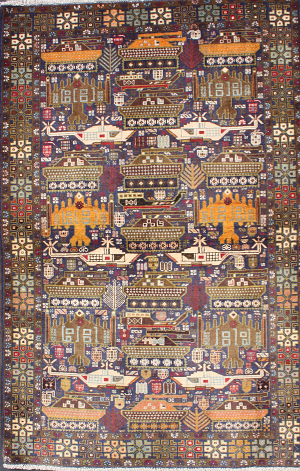 | F-16 Rugs Only a few of these rugs have passed though our hands but they are very interesting and beautiful. They feature rows of weapons including jet fighters which sometimes have "F-16" written on the bottom. These rugs were first seen in mid 1999 with the "F-16" writing, and they all predate 2001. |
| Bomber / Helicopter / Tank War Rugs We saw many of these rugs in 2000. The primary motifs are simple bombers, fat cargo helicopters and stylized tanks accented with trucks and floral motifs. They were often very dusty with mud on the back. Some tribal weavers cake the back of rugs with mud while weaving to set the knots in place. |
 | Baghlani War Rugs Beautiful rugs. Sometimes wool warp, sometimes cotton. These often have navy blue fields that have faded to black. The pile tips brown slightly and the net effect is black. These rugs have short and very dense pile that is very evenly clipped. Helicopters appear to have skis and armored personnel carriers are common. |
 | Diamond Herati (Lozenge Field with ""+"" Shaped Medallion"" This style is important because it sometimes employs the ""fish"" from the classic Herati or Fish Pattern. This style features an elongated medallion shaped like a pointy lozenge. These are usually very fine quality with good wool, depressed warp, high knot counts and beautiful designs. This style breaks into two sub styles. One features a geometric lozenge with a jagged multi-lined edge, while the other sub style feature a lozenge with plant forms sticking out horizontally which look like half peeled bananas. |
| Latif Chel War Rugs Some Baluch rugs have a distinct 8 lobed medallion with a complicated linear outline. Sometimes the medallions are tightly closed and other times the edge is diffuse. Latif Chel war rugs, and Latif Chel Baluch rugs generally, are often extremely fine, and the best Afghan tribal rugs. |
| Red Rugs, a war rug classic. Formerly the most common style of war rug, supplies have been limited in 2002 and 2003. Kalashnikovs on sides with miscellaneous weapons throughout the fields. Almost all have exclusively weapons, no floral, geometric or figurative motifs. These red rugs appear to be an adaptation of traditional Turkmen rugs calle Bokara or Bukhara. They are also known as Elephant Foot design. Warrug does not traffic in traditional rugs, but here is an example of a 19th century Bokara rug. |
| Chechen War Rugs Chechens are commercial Kazak patterns woven with a Turkman structure in Pakistan. Occasionally a weaver sneaks in some weaponry giving us the odd war rugs. Heavy duty rugs. Hard wearing with fully depressed warp usually. Attractive patterns whose best parts are the freeform secondary motifs. |
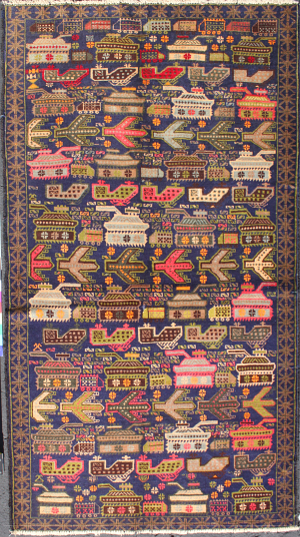 | Rows of Weapons War Rugs This is an indistinct style which features rugs whose primary motif is weaponry laid out in rows. Baghlanis would fall into this style if they did not form a group of their own. |
| "Afghan Kazak" War Rugs Very rare to find war motifs in these rugs. These are very high quality commercial rugs coming from Pakistan. They feature Kazak and Caucasian designs woven with the traditional structure; symmetrical knot, no warp depression, short pile, wide singles. |
 | Golden Border War Rugs (without ewers) This is an interesting group since it often features women in burkas. These rugs have a light border usually containing tanks with guns up and highly stylized helicopters as well as secondary motifs of grenades and rifles. The field may contain figures which look very much like airplanes except they often feature eyes and less often a mouth. |
| AFGHAN Musical Band Some people, from one example published in an advertisement, ascribe this group to being Japanese, but the images of traditional band predate the Japanese example. |
| Prayer War Rugs Prayer format war rug. Very rare. |
| Pixilated War Rugs These rugs are the most aggressive designs. They feature weapons mashed together and drawn with a very pixilated line. The line gives a jagged and harsh feel to the drawing which is well suited to the subject matter. |
 | AK-47 White Field War Rugs Some of these rugs may have been made in Iran. Typically they feature one AK-47 with other mechanized armor laid out throughout the field. They often feature poppies as well. |
| Car Style War Rugs This style needs to be broken into two styles. The rugs it originally encompassed featured cars as well as other motifs, most noticeably helicopters with a concentric lines pattern on the tail. They are typically very soft and fine wool. |
| Vegetable Dye War Rugs Most vegetable dye rugs are limited production rugs coming from commercial enterprises in Pakistan. Quality can be quite good with hand spun yarn. |
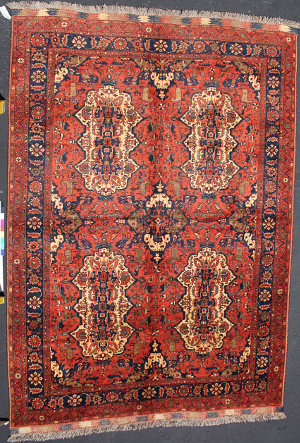 | Kul Mohammedi War Rugs We have only seen one rug of this style, and it is a real gem. Super quality. Great color. Nice size. |
| Flat Weaves Rugs with out pile. These rugs have a different vocabulary of motifs. They are nice accents to a collection. |
| American Weapon Red Rugs New rugs featuring American weapons. These are going to be the new type. The ""Jet Fighter (Underside View)"" is a subset of this type, but the ""Jet Fighter (Underside View)"" existed before the war on terrorism brought American forces to Afghanistan and Pakistan. These rugs will make the Soviet era rugs a discreet group, relegated to a particular moment in history. It will be interesting to see how the patterns develop. |
| Anomaly War Rugs Misc. un-categorized styles |
| Vase of Flowers War Rugs Feature one or many vases of flowers. Often top quality Beluch pieces. |
| Checkered Areas (two colored threads) This type is defined by areas of pile where an area is filled with alternating colors; either from one knot to the next, or two colors of thread are spun into one yarn. |
 | Banana Medallion War Rugs This style is typified by a long lozenge shaped medallion with forms protruding laterally which look like half peeled bananas. The two we have seen with war rugs, are very nice quality. |
| World Trade Center Flag Banner War Rugs This style has proven controversial. This type of rug was woven in Pakistan by Afghan refugees. After the U.S. took out the taliban these weavers were able to return to their traditional home in northern Afghanistan, particularly Sherberghan and Mazar-e Sharif. |
| Najibullah War Rugs Civil War This style is a pattern dating to 1991-1993 when the Soviets installed a puppet government. The leader, here depicted with a hammer and sickle tattooed on his forehead, name was Dr. Najib (during the Soviet war) or Najibullah (before and after the Soviet war). He was eventually brutally killed by the taliban. |
| Tora Bora Large w/ Hand Spun Rare style. Debut 2003. ""These rugs really show what we are getting at over there."" -U.S. Air Force Pilot |
| Tora Bora Sherberghan Latest iteration of earlier small yellow map rugs. |
 | Pool and Mosque Pictorial Rugs Pictorial rugs with a primary image of a Mosque with a reflecting pool. |
| All Over Fighter Jets War Rugs This is a Zakini pattern with triangular jets filling the field. |
| White Field with Stylized Helicopters This design is something of a puzzle. Perhaps Chahar Aimaq or possible Chichtactu. |
| Horsemen War Rugs This pattern of war rugs depict men with weapons on horseback. |
| Sea Knight Tora Bora War Rugs Bruce from set us straight on helicopter model shown in this rug. |
| Abstract WTC War Rugs Small group available mid 2002 |
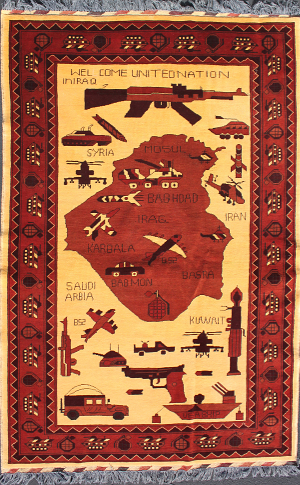 | Kharghai (Workshop) Rugs woven in workshops, mostly in Peshawar during the 1990s. Some workshop rugs now originate from Northern Afghanistan, woven by weavers who were refugees in Pakistan during the 1990s but returned to their Afghan homes after the Coalition drove the Taliban from power in 2001. Workshop rugs are different than tribal rugs which are usually woven at home. |
| Political Portraits Photographic type portraits |
| Non War Rug Mostly Baluchi Rugs of interest, without war motifs |
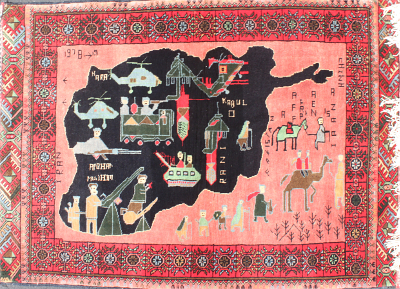 | Maps of Afghanistan Turkmen before Soviet Exodus or Baluchi Afghan Maps |
| ZPU-4 Prayer Rugs (Feedback Loop) Please see blog posts about this style |
| WTC War Rugs - No Flag Banner War Rugs showing the September 11 terrorist attack on the World Trade Center. These rugs do not show the Afghan and American flags and white dove of peace |
| Ghazni Red Rugs with Map Red rugs usually with wool foundations which employ excellent quality Ghazni wool |
| Yellow with Crossed AK's Best Yellow Patter. |
 | Triple Six Side Medallions The medallions are generally outlined in with leafy line. |
| Kabul Landscapes Kabul |
| Four Panel Landscape (2X2) Four views laid out in a two by two grid |
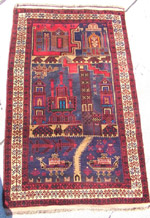 | Three Panel Landscape One Scene broken into three panels, foreground (airport), middle ground, background |
| Paghman Lake Monuments Amman Ullah Khan built these monuments to soldiers who died fighting the English. |
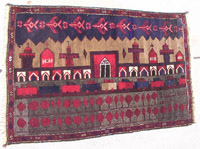 | Herat Mosque (Trees, Road, Arches) Classic design |
| Scattered Flags Tora Bora Rug No dove banner, but multinational flags scattered throughout field |
| British Flag Banner Tora Bora Brit flag added to Afghan and US flags joined by white dove of Peace |
| Tower Landscape Jam and others |
| Chechen Tora Bora Small group of Tora Bora Rugs |
| Blue Red Rugs Red Rugs but with blue fields |
| Ghazni Wool Red Rugs - Hand Spun Small production of red rugs using hand spun Ghazni wool and wool foundations |
| White Red Rugs Red Rugs but with white fields |
| Herat South View of Mosque Looking north with Friday Mosque in middle ground and mountains in background |
| Tora Bora No Foreign Flags No white dove flag banner or scattered flags |
| Unexploded Ordnance Excellent rugs. |
| Mount Fuji Rug Inexplicably, Afghan rugs depicting Japan |
| Two Panel (same twice) The same image twice, top to bottom |
| Mythic Figure War Rugs War Rugs showing mythic characters and stories |
| RPG Red Rug The symmetry of this design makes it particularly beautiful, and linked more closely to older Turkmen rugs, called Bokara (Like this one Rug #3333, and antique Borkara rug with condition issues |
| Figurative - Traditional Baluch Representation Very old pictorial convention for drawing figures |
| Modern City Landscape Mostly after 2001, urban, mechanized cities w/o specific war motifs |
| Iraq Rug - Uzbeki Iraq war rugs, as of 2007 there have been three generations of this rug. |
| Mashad Influence Workshop The people from this workshop clearly learned their trade in Mashad. |
| M16 Tora Bora Similar patter to the Large Tora Bora Rugs with Hand Spun but the material and structure is totally different. |
| Beljik Rows of Weapons Belgian style wool |
| Jacub Khani War Rugs Traditional Baluchi Design meaning ""House of Jacob"" |
| Mushwani War Rugs (not Amman Ullah Khan) Small group of Pashto weavers working in Baluch like styles |
| Dokhtar I'Khazi Traditional Afghan Baluchi design whose name means ""The Judges Daughter"", ostensibly the originator of the design. |
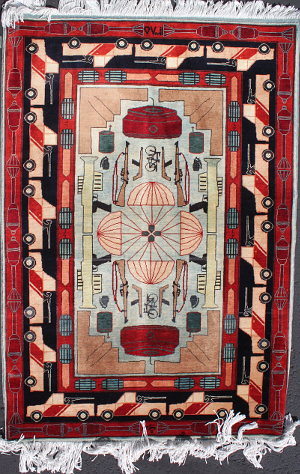 | Peshawar - Kabul - Hand spun |
| Telephony One foot square rugs which were originally made to go beneath a old fashioned rotary phone. Some early examples had images of phones. Most Telephony rugs don't show arms, but the ones featured here all include rugs. |
| "Afghan Modern" Map War Rugs As defined by Nigel Lendon as described in this lost post: https://rugsofwar.wordpress.com/2012/07/16/the-afghan-modern-its-anonymous-authors-and-the-question-of-collective-agency/ and this show. |
| Tree of Life Design Not many war rugs feature the tree of life which is important and plentiful in antique rugs. |
| World Map Rugs Influenced by the work of Alighiero e Boetti. |
| Late Car Style (2010's and beyond) This style is derived from the "feedback loop", where important vintage rugs are copied in contemporary rugs. The original Car Style from the 1980's commands big prices, so it seems someone thought by adding the simple car images it would improve the attractiveness of their new rugs. |
| Lion Rugs Lions are an archetypal image of Persians and many Afghan. |
| Tyne Bridge and Swing Bridge in Newcastle, England What a bridge in Newcastle England is doing on an Afghan rug stumps me, but Max Allen of Canada's Textile Museum has suggested that these images of Europe come from a calendar or tourist imagery. |
| Masjid Malabar on Victoria St. Singapore
This identification came from a viewer of this site. Community input is why I built and maintain this site. |
| Predator Drone US Predator Drone, no longer in use. |
| Reaper Drone War Rug |
| Three Drone War Rug Predator, Reaper, and Global Surveyor UAV war rugs. |
| Drone Medallion These drone medallion rugs appear to be an adaptation of traditional Bokara, or Bukhara, rug. They feature major guls, like elephant foot, and minor guls. 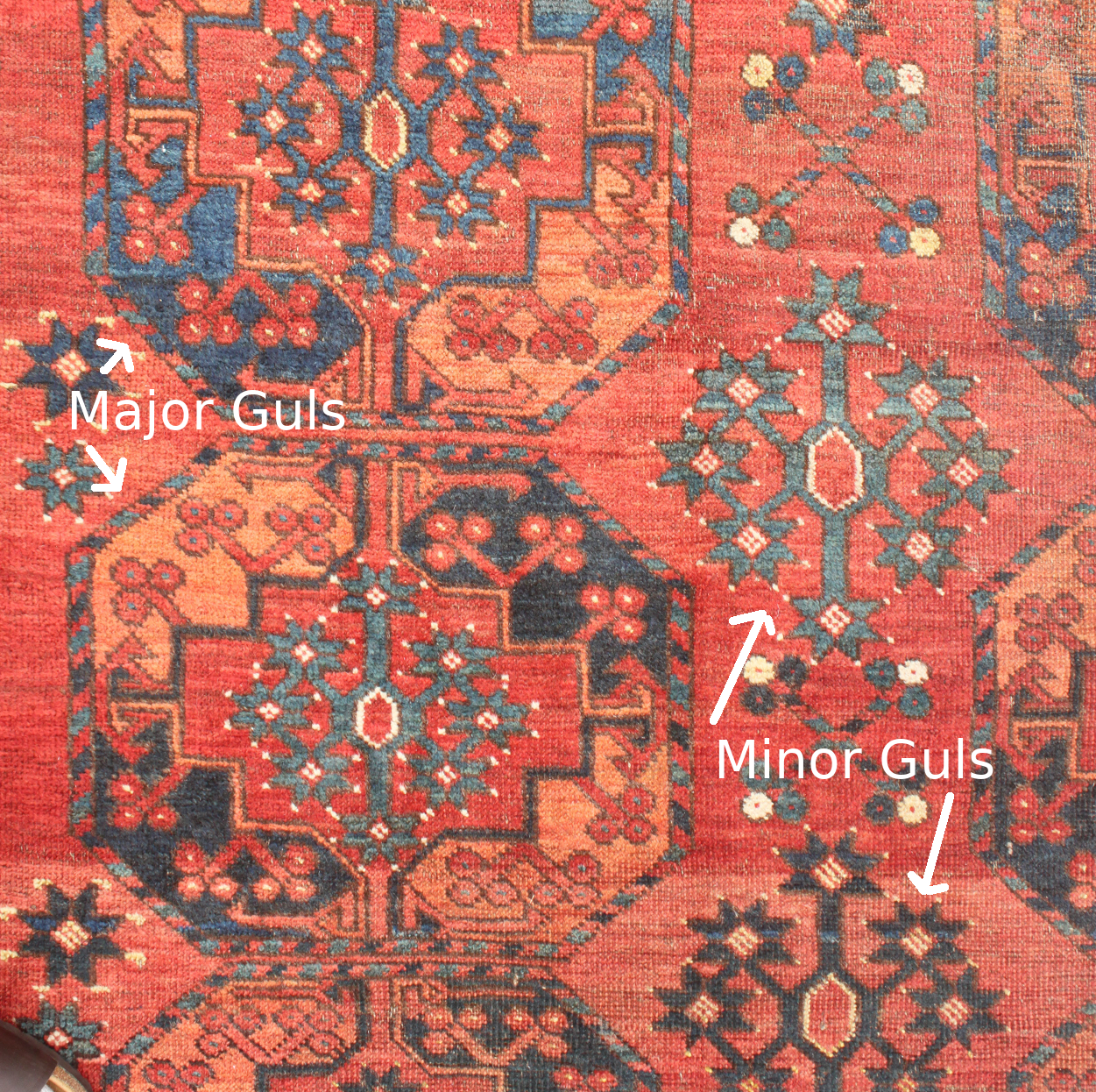
Here is an antique example of a Bokara rug, #3333 |
| Stinger Missiles and Daisy Cutters Inventory of weapons from the Afghan Wars of the last 100 years. |